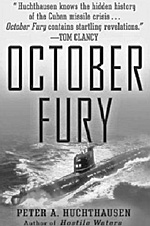 October Fury, by Peter A. Huchthausen, John Wiley & Sons, 2002, 281 pp, $24.95 (hardcover)
October Fury, by Peter A. Huchthausen, John Wiley & Sons, 2002, 281 pp, $24.95 (hardcover)
Amidst all the paper being written about the political and diplomatic confrontation between President John F. Kennedy and Premier Nikita Khrushchev during the Cuban Missile Crisis over forty years ago, a long overdue volume describing some of the intense naval operations in the Caribbean between the Soviet and American navies in October, 1962 has finally emerged.
October Fury explores the implementation of the naval “quarantine” in response to the discovery of Soviet missiles in Cuba by American reconnaissance aircraft. While establishing the blockade along the famous Walnut Line, American destroyers and antisubmarine aircraft discovered a group of Soviet long-range Foxtrot-class submarines on their way to Cuba as the vanguard of a permanent Soviet naval presence in the Caribbean.
Stopped short of their objective by vigorous American ASW, the interaction between the Soviet submarines and American forces reads like an account from the Battle of the Atlantic. A chilling fact brought out in the book in great detail is the revelation that each Soviet sub captain was authorized to fire nuclear torpedoes if they decided they were under attack. The question of nuclear weapons release from the Soviet perspective is fascinating. A retired Navy captain, Peter Huchthausen served as an junior officer on one of the WW II-era destroyers in the blockade. He also shares his extensive experience as a naval attaché to Moscow, Yugoslavia, and Romania during the Cold War.
While describing events as his ship tangles with one of the Russian submarines, he gives his readers an insight into 1960s naval technology and antisubmarine tactics. The author also does a remarkable job of sharing what it is like to serve on an American naval vessel.
To compliment his own experiences, the author has gone to great lengths to tell the Russian side of the story using personal observations and accounts from surviving Soviet sailors and officers. Lists of Russian and American primary and secondary sources in the index attest to his efforts to present a balanced account and serve as a jumping off point for people interested into getting more information about naval operations during the crisis. The sections of never before published Soviet submarine photos bring the book to life. Naval enthusiasts and wargamers interested in this era should have this book on their shelf. Although it does not cover the entire scope of naval operations during the crisis, this book offers a starting point for generating scenarios and building naval orders of battle (forthcoming in Clash of Arms’ Stars and Stripes). After turning the last page, the reader will feel like screaming for more.
BT
Back to The Naval Sitrep # 25 Table of Contents
Back to Naval Sitrep List of Issues
Back to MagWeb Master Magazine List
© Copyright 2003 by Larry Bond and Clash of Arms.
This article appears in MagWeb.com (Magazine Web) on the Internet World Wide Web.
Other military history and related articles are available at http://www.magweb.com